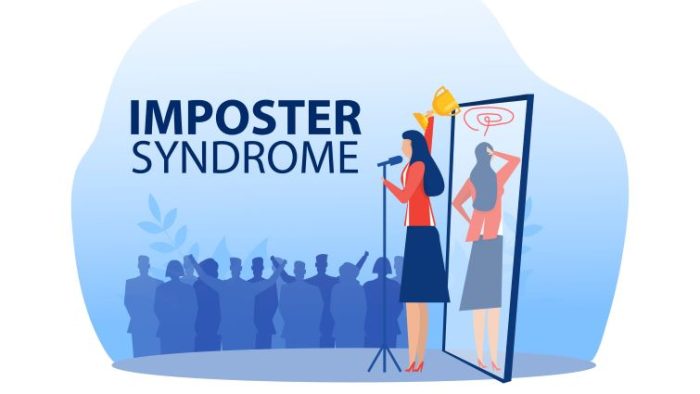How to Identify and Overcome Imposter Syndrome in the Workplace
 Publié le 7 January 2025
Publié le 7 January 2025
Boost your confidence and your career by understanding how to identify and overcome imposter syndrome in the workplace.
Imposter syndrome can creep in when you least expect it. You feel like a fraud, even though your hard work and achievements prove otherwise.
Also known as the “imposter phenomenon,” this psychological experience often leaves you questioning your worth and fearing failure. Researchers Pauline Rose Clance and Suzanne Imes coined the term after studying high-achieving women who often feel like they don’t measure up.
The good news? There are strategies you can use to help you reclaim your confidence.
Let’s take a closer look at how both employees and Human Resource (HR) teams can tackle impostor syndrome, increase job satisfaction, and create a healthier workplace environment.
7 practical ways employees can spot and overcome imposter syndrome at work
Start by understanding how imposter syndrome manifests in your daily work life. The following practical strategies can help you recognize and overcome it.
1. Audit your internal dialogue
Do you downplay your achievements or avoid taking credit for your work?
Maybe you think, “I just got lucky,” or feel uneasy when receiving praise. These are strong signs of imposter syndrome. Journaling can help you pinpoint patterns — when are these thoughts most common?
For example, you may notice that these feelings surface most when presenting to your leadership panel or during performance reviews. Recognizing the context can help you prepare and shift your mindset. For instance, you might schedule time to practice your presentation. Or you might recite positive “I Am” statements before a review.
2. Reframe negative thoughts
Negative thoughts can spiral fast. When they appear, actively challenge them. Write them down and counter them with facts that inspire self-confidence. Doing this will help counteract the effects of imposter syndrome.
For instance, if you think, “I’m not good enough for this role,” remind yourself about times when you delivered great results or exceeded expectations in the past. Even a simple affirmation like “I’m capable and improving every day” can retrain your brain over time.
It’s also important to practice not tying your self-worth to what others may think about you.
Recognize that you are worthy exactly as you are. Focus on your genuine excitement for accomplishing your goals instead of trying to win approval from others.
3. Document your wins
A “wins folder” isn’t just a feel-good exercise. It can really help you refocus when self-doubt strikes.
Consider creating one with performance reviews, screenshots of client or coworker praise, and successful projects. If a whole folder feels daunting, start with one note or sticky reminder on your desk, like, “I led the team to complete X project two weeks ahead of schedule.”
This creates a tangible reminder that your contributions are real and valuable.
Over time, reviewing these wins will shift your mindset from “I hope I’m good enough” to “I’ve proven I’m more than capable.”
4. Use AI tools for clarity
Sometimes, symptoms of imposter syndrome pop up because you’re feeling pulled in too many directions. Multitasking is very common, but is an ineffective way to get your work done.
Or because you’re worried you don’t have enough information to move forward on a task or project.
This is where AI automation tools can help.
Use AI to take meeting notes to make sure you’ve captured every important detail. This can help reduce anxious thoughts and give you more mental space to actively participate in the conversation.
5. Challenge perfectionism
Perfectionism and other symptoms of imposter syndrome often go hand in hand. Shift your focus from flawless results to meaningful progress by breaking large projects into smaller, achievable goals.
For example, instead of saying, “This presentation needs to go well,” aim for, “I’ll make sure the key points are clear and well-supported.” Celebrate completing each step, even if it’s not 100% ideal. This helps you see value in your efforts, not just the end product.
6. Practice self-compassion
Everyone makes mistakes — so be kind when speaking to yourself if you’ve made one.
If you’re hard on yourself or stressing out, pause. Ask yourself, “Would I say this to a colleague in the same position?” Probably not.
Start treating yourself with the same kindness and encouragement.
For example, after a bad presentation, instead of saying “That was awful,” practice saying, “It didn’t go as planned, but I learned something for next time.”
7. Take on new challenges
Push your boundaries incrementally. Volunteer for a task you’ve been hesitant to try — like leading a meeting or pitching an idea. Even small successes in these areas can build your confidence over time.
For instance, if public speaking intimidates you, start by presenting in smaller team meetings before moving to larger audiences. Each win reinforces your ability to grow and adapt.
How HR support can help employees facing imposter syndrome
HR support plays a pivotal role in creating an environment where employees feel supported and empowered to tackle imposter syndrome in the workplace.
Here are ways to foster that culture.
Foster a supportive culture
Create a workplace environment where employees feel safe to acknowledge challenges and combat negative thoughts with encouraging words.
Encourage managers to offer specific, actionable, positive feedback and celebrate wins publicly (like in team meetings). For example, instead of saying, “Good job,” a manager might say, “Your attention to detail made the report much stronger. Thanks for your help on this, Maria.”
Use employee monitoring solutions to spot support needs
When used transparently, employee monitoring solutions can help employees see the impact of their work without micromanagement.
For instance, tools like ActivTrak can highlight areas of high efficiency or underutilized strengths. Share this data through supportive conversations to help reduce self-doubt and provide a roadmap for growth.
Promote collaboration with apps
Foster open communication and peer-to-peer mentoring with apps for employees. Create dedicated channels where employees can share experiences, discuss self-doubt, and access helpful resources, such as workshops or confidence-building articles.
Highlight mentorship programs
One-on-one mentorship can be really supportive for employees struggling with self-doubt.
Pair employees with experienced mentors to help them gain valuable insights, build confidence, and increase job satisfaction.
Wrap up
Imposter syndrome doesn’t have to define your workplace experience. By identifying negative thoughts early and implementing strategies to combat them, you can build confidence and thrive in your role.
For organizations, supporting employees with resources and fostering a culture of openness can reduce the effects of imposter syndrome across the board.
Take the first step toward a more confident workforce knowing how to identify and overcome imposter syndrome in the workplace.







